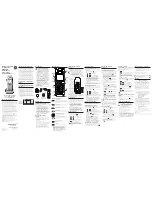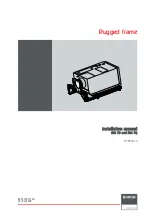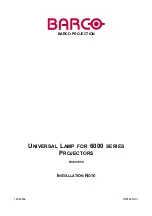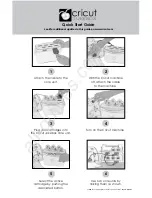
Quick Start Guide
Specifications
IMPORTANT:
Not intended for use with
life support equipment.
Contact Information
Mailing
1628 – West Williams Drive
Address:
Phoenix, AZ 85027 USA
Web Site:
www.outbackpower.com
Date and Revision
August
2020, Revision A
Audience
This guide is for use by qualified personnel who meet all local and governmental
code requirements for licensing and training for the installation of batteries and
related products. The installer should be familiar with battery test procedures.
Be sure to review carefully and identify potential safety risks before proceeding.
The installer must be familiar with all features and functions of this battery before
proceeding. Failure to install or use this battery as instructed can result in
damage to the battery that may not be covered under the limited warranty.
Product
The EnergyCell
™
TT is a series of top-terminal 12 Vdc valve-regulated lead-acid
(VRLA) absorbed glass-mat (AGM) batteries. These batteries are for backup or
light duty cycling applications.
Storage
o
All lead-acid batteries experience self-discharge while in storage. This
causes circuit voltage and capacity to decrease.
o
The self-discharge rate is related to ambient temperature. The lower the
temperature, the lower the discharge rate. Batteries should be stored in
a clean, ventilated, and dry location with an ambient temperature of
32°F to 77°F (0°C to 25°C).
o
It is important to track open-circuit voltage (OCV) when batteries are
disconnected. If OCV i
s lower than 12.6V or the batteries have been stored
beyond the limits shown in the
Storage Time vs. Temperature
graph, t
he
batteries should be charged to avoid damage caused by self-discharge.
o
Recharge at 14.4 Vdc for 12 hours prior to battery reaching 12.6 Vdc.
o
All batteries should be fully charged before storage. Record the storage
date and next supplemental charge date in a maintenance record and
on the battery. See the voltage log on the next sheet.
o
Upon battery deployment, verify that all batteries within each string measure
in the range of +/- 0.3 Vdc of the string average while in "float" charger mode.
Capacity
The battery’s actual capacity is influenced by temperature, depth of discharge,
discharge rate, and the resulting voltage.
o
The higher the discharge rate, the lower the available capacity.
o
The available capacity is also reduced as batteries become colder. This is
related to the internal electrochemical reactions and the resistivity of the
electrolyte. It is depicted in the
Capacity vs. Temperature
graph.
Note that battery cycle life is also affected by depth of discharge, as shown in the
Cycle Life
graph.
Operating Conditions
EnergyCell TT batteries are valve-regulated and sealed. They do not give off
perceptible amounts of gas under normal operating conditions.
o
Operating temperature range (ambient): –40°F to 140°F (–40°C to 60°C)
o
Optimal operating temperature (ambient): 68°F to 77°F (20°F to 25°F)
o
Ambient humidity:
≤
95%
EnergyCell TT Series Battery
Electrical
900-00270-01-001 REV A
©2020 OutBack Power. All Rights Reserved.
NOTE:
Although the battery can operate at
temperatures below –4°F (–20°C),
the capacity and ability to discharge
will be dramatically decreased.
Perce
nt State
of
Charg
e (%
)
Storage Time (Months)
0 2 4
6 8 10
12 14 16 18
20
22
24
100
95
90
85
80
75
70
13.00
12.95
12.90
12.85
12.80
12.75
12.70
12.65
12.60
Vol
tage
Storage Time vs. Temperature
Perce
nt Rat
ed
Cap
acity Avai
lable (%)
100
90
80
70
60
50
40
30
20
10
0
Temperature
–40°F –22°F –4°F 14°F 32°F 50°F 68°F 86°F 104°F
–40°C
–30°C
–20°C –10°C 0°C 10°C 20°C 30°C 40°C
Capacity vs. Temperature
Number of Cycles
(times)
200
400
600
800
1000
1200
Cap
acity (%)
120
100
80
60
40
20
0
Cycle Life
at different depth of discharge (DoD) levels
Mechanical
Environmental
106TT
Threaded alloy insert terminal to accept M6 × 20 mm bolt
44.9 in-lb (5.1 Nm)
115TT
Specification
Terminal Type
Terminal Hardware Torque
1 year
Warranty
66.56 lb / 30.2 kg
75.38 lb / 34.2 kg
Weight
8.41 × 12.78 × 6.65"
213.6 × 324.7 × 169.0 mm
8.54 × 13.5 × 6.69"
216.9 × 343.0 × 170.0 mm
Dimensions (H × L × W)
27
31
Case Size
106TT
12 Vdc
6
115TT
Specification
Nominal Voltage
Cells per Unit
500 cycles
14.4 to 15 Vdc
Cycle Life (50% Depth of Discharge)
Absorption Voltage (25°C)
3.5 hours
13.5 to 13.8 Vdc
Absorption Time
Float Voltage (25°C)
24/7
15 Vdc for 16 hours every 2 months or 25 cycles
Float Time
Equalize Voltage, Time, and Frequency
12 Vdc
30 Adc
33 Adc
Re-Bulk Voltage
Maximum Charge Current (per Battery)
±3.3 mV per cell per °C
12 months at 77°F (25°C) before a recharge is required
Temperature Compensation Factor
Self-Discharge Frequency
106TT
–40 to 140°F (–40 to 60°C)
14 to 104°F (–10 to 40°C)
115TT
Specification
Operating Temperature (compensated)
Storage Temperature
Ampere-Hour Capacity to 1.75 Volts per Cell @77°F (25°C)
Discharge in Hours
1
65.5
81.7
2
75.2
91.0
3
80.7
96.3
4
84.0
100.0
5
86.5
99.0
8
90.4
104.0
10
94.0
104.0
20
100.0
112.0
24
101.2
111.3
48
104.6
115.2
100
106.0
117.0
Model
EnergyCell 106TT
EnergyCell 115TT
100% DoD
100%
DoD
50%
DoD
30%
DoD






















